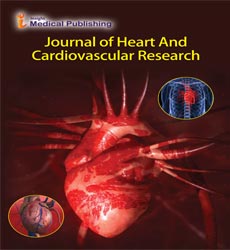ISSN : ISSN: 2576-1455
Journal of Heart and Cardiovascular Research
Understanding the Impact of Coronary Artery Disease: A Global Health Emergency
Faizal Anggraeni*
Department of Cardiovascular Research, University of Indonesia, Jakarta, Indonesia
- *Corresponding Author:
- Faizal Anggraeni
Department of Cardiovascular Research, University of Indonesia, Jakarta,
Indonesia,
E-mail: Faizalanggraeni@gmail.com
Received date: May 01, 2024, Manuscript No. IPJHCR-24-19363; Editor assigned date: May 04, 2024, PreQC No. IPJHCR-24-19363 (PQ); Reviewed date: May 20, 2024, QC No. IPJHCR-24-19363; Revised date: May 27, 2024, Manuscript No. IPJHCR-24-19363 (R); Published date: June 03, 2024, DOI: 10.36648/2576-1455.8.2.64
Citation: Anggraeni F (2024) Understanding the Impact of Coronary Artery Disease: A Global Health Emergency. J Heart Cardiovasc Res Vol.8 No.2: 64.
Description
Coronary artery disease or cardiovascular disease, is a heart disease that damages the heart and all the blood vessels in the body, caused by the accumulation of plaque in a person's arteries and can lead to stroke or heart attack. Coronary artery disease is the leading cause of disability and premature death worldwide and contributes significantly to healthcare costs. Based on statistics from the American Heart Association (AHA), the AHA recorded as many as 370,213 deaths from coronary heart disease in 2013.
Coronary artery disease
According to the World Health Organization (WHO), 7.4 million people died from coronary heart disease worldwide in 2012. Among Indonesian cases, coronary artery disease was the leading cause of death in all age groups, namely 12.9%, based on 2014 SRS data. At risk data from 2013 showed that the highest incidence of cardiovascular disease in Indonesia was coronary heart disease, which was 1.5%. Because of the high mortality rate, detection of heart disease is essential to reduce deaths caused by heart disease. To diagnose heart failure, the doctor takes the patient's medical records and then examines the symptoms. The doctor also checks the percentage of existing risk factors, such as high blood pressure, Coronary Artery Disease (CAD) or diabetes. However, the examination takes a long time, because to get the correct diagnosis. Therefore, there is a need for an analysis method that can detect heart disease in a short period of time. One solution to quickly detect heart disease is to analyze the patient's Heart Rate Variability (HRV) signal. Patients with heart failure can be monitored using a HRV signal. HRV signaling reflects the interaction between two subsystems (sympathetic and parasympathetic) that influence the cardiovascular system. HRV signals can be used to determine the patient's current condition. Evaluation of HRV was performed by analyzing short-term and long-term Electrocardiogram (ECG) recordings. The ECG itself is a wave record of the heart's electrical activity, consisting of P waves and T waves. The amplitude of the ECG signal varies according to the location of the electrodes and the physical condition of the patient.
ECG recording allows doctors to determine the condition of the patient's heart, because the results of the ECG recording show the characteristics of the heart. Results of the higher order low fluctuation analysis functions are used as input to a neural network classifier to determine differences in HRV signals between heart failure and normal patients.
Autonomic dysfunction
Neural network is ideal for predicting diseases of patients. In particular, an artificial neural network matches the non-linear correlation of input and output variables until it reaches high accuracy. Neural network model was used to predict the occurrence of hypertension, cardiovascular autonomic dysfunction, coronary artery disease and metabolic syndrome. Based on previous studies, the artificial neural network model can accurately predict various clinical conditions and outperform traditional statistical methods. Therefore, the artificial neural network is considered suitable for predicting the condition of patients with congestive heart failure. HRV signal is a signal with non-linear structure and non-stationary data pattern. The HRV signal is also scale invariant. The HRV signal has a non-stationary property that shows the correlation between distance (memory) and frequency variability (volatility). Therefore, de tended fluctuation analysis is a suitable method for processing HRV signals, because this method is suitable for data with a non-linear and non-stationary structure. The method used in this study is higher order moment protected fluctuation analysis. The higher order moment protected fluctuation analysis method investigates the volatility scaling property of the heart rate HRV signal. Higher-order moments de tended fluctuation analysis is a more appropriate method than de tended fluctuation analysis because this method calculates the skewness and kurtosis of the HRV signal. The skewness indicates the value of the asymmetry of the probability distribution of a real-valued random variable with respect to its mean. While kurtosis shows the change in value of the tail. Skewness and kurtosis values show the nature of volatility in time series data from different perspectives to provide more interesting information.
Open Access Journals
- Aquaculture & Veterinary Science
- Chemistry & Chemical Sciences
- Clinical Sciences
- Engineering
- General Science
- Genetics & Molecular Biology
- Health Care & Nursing
- Immunology & Microbiology
- Materials Science
- Mathematics & Physics
- Medical Sciences
- Neurology & Psychiatry
- Oncology & Cancer Science
- Pharmaceutical Sciences
